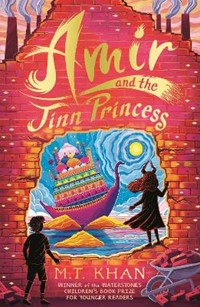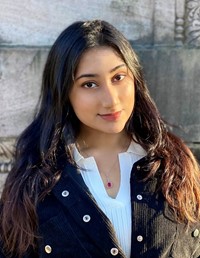MT Khan


About Author
MT Khan is back to tell us about her new novel, Amir and the Jinn Princess, which returns us to the world of her debut novel, Nura and the Immortal Palace.
MT Khan is a SFF writer from Pakistan, now living in Canada. She focuses on stories close to her heart, evoking cultural and societal conversations through her works. She lives in Toronto, Canada, with a hyperactive cat and an increasing selection of fantasy video games.
You can find MT Khan on X @maeedakhan
Interview
Amir and the Jinn Princess (Walker Books)
July 2024
Enter a richly-imagined world of jinn, enchantments and magic in Amir and the Jinn Princess. When pampered Amir finds himself in the land of the jinn, he at last has the chance to discover what lay behind his mother's mysterious disappearance a year previously.
Author MT Khan tells ReadingZone how her childhood links with Pakistan and her own adventures help inspire her landscapes and her stories, and reflects on some of the themes of capitalism and selfhood that she explores in Amir and the Jinn Princess.
Amir and the Jinn Princess is set in the same world as her earlier novel, Nura and the Immortal Palace, but is a stand-alone story.
Review: "A beautifully written story entwined with culture, magic and secrets." Read a chapter from Amir and the Jinn Princess
Q&A with MT Khan
"Amir and the Jinn Princess packs all the whimsy of a Ghibli movie
with the heart of a classic fairytale."
1. Thank you for joining ReadingZone this month, we'd love to know a little more about you. What has life been like as a published author since your debut was published?
Since publishing my debut, Nura and the Immortal Palace, I get at least three DMs every week from fans detailing how and why they enjoy my book. I once got a message from a mother who said her daughter dressed as Nura for character day at school! I couldn't stop smiling for hours. It's the small things, I've realized, that make life feel slightly more shimmery, and my heart just a tad bit more fuzzy.
2. Can you tell us a little about your new book, Amir and the Jinn Princess?
Amir and the Jinn Princess packs all the whimsy of a Ghibli movie with the heart of a classic fairytale. This story follows two characters, Amir, the potential heir of a very wealthy Pakistani company, and Shamsa, a princess to the magical jinn kingdom. They become reluctant allies when Amir wants her help to find his mother, and the jinn princess needs his help win the throne. But a terrible secret might shatter everything they've been working for…
"I specifically wanted to write about Lahore because that's where my family is from, and every time I visit,
it's those streets that call to me and ask for a story to be written."
3. We first met these two worlds of Pakistan and the Jinn in your debut title, Nura and the Immortal Palace. Why did you choose the Pakistan setting, and what drew you back for your second book?
Pakistan is my birthplace, and though I may not live there now, writing about it allows me to feel connected to it. I specifically wanted to write about Lahore because that's where my family is from, and every time I visit, it's those streets that call to me and ask for a story to be written.
4. What was it like seeing the world through the eyes of an entitled, wealthy 12-year-old boy, Amir? Why did you choose brick making as his family's business?
Well, I certainly wasn't writing from experience. I just called upon a snobbish, wealthy boy as my spirit animal when writing this story. It was more fun than I thought - I found myself being judgemental about everything, which in a positive way made me think more deeply about everyday things, but also became quite exhausting rather quickly.
Brick kilns are very common in Pakistan, and I actually knew someone who had a brick-making business. I also think there's an allegory between bricks and labour somewhere in there too.
5. How did you start to create your world of the Jinn, and your jinn character, Shamsa?
I mostly wanted to expand the realm of jinn, as we only see a single tourist island in Nura and Immortal Palace. I wanted to dream up an entire kingdom, where its royals are competing against one another to earn their denizens' favour. Readers are able to travel across the kingdom and learn about its beauty and faults, right alongside the characters.
Shamsa is my version of a manic pixie dream girl, but make it manic jinn nightmare girl. She may seem like just a quirky ball of joy at first glance, but there're many layers hiding underneath.
"I think as storytellers, our job is to bring the attention of the public onto something
that matters to us, or society, or the world."
6. Through Amir's journey in the Jinn's world, you explore child labour and the cycle of poverty,
subjects you also addressed in Nura's adventures. Do you feel, as an author, you should shine a light on inequality?
I think as storytellers, our job is more to bring the attention of the public onto something that matters to us, or society, or the world. I find myself learning things hidden deep from the surface, and wanting to shine a light on them. The clandestine is a rotten tree whose roots are still alive underground - I'll dirty my hands to dig it up.
7. Why did you also want to explore bereavement and how it can affect young lives through this story?
There is the grief of losing someone, but also the grief that's part of coming of age. There's a sense of maturity you must uphold to, the sense that all that was promised to be well, sometimes isn't. I wanted to explore this concept of grief not just as it relates to people, but also to personhood, and I think it will strike a chord with many young readers who are going through similar trials and realisations.
8. Amir and the Jinn Princess is a great adventure quest, but also gives the reader much to think about. What would you like your readers to take from Amir's journey?
Anything they want to! This will be their story as much as it is mine.
9. Do you plan to return to this world in future stories? What are you writing currently?
I have an idea for a third installment in the Realm of Jinn series. I can't make any promises, but the idea is brewing. In other areas of fiction, I am working on more fantasy novels for young adults and adults.
10. There is a lot of travel and adventure in your stories - does this reflect how you like to live your life in the 'real' world, or are you an armchair adventurer?
I absolutely delight in travelling. It is the one thing I drop everything for - I am always ready to start a new adventure. Whether it's the canals in Venice, the ancient ruins in Peru, or the bustling spices of Pakistan, I will be there.
MT Khan introduces her debut, Nura and the Immortal Palace (Walker Books)
Nura and the Immortal Palace is a magical adventure with trickster jinn, an enchanted hotel that meets every guests's whim, and a group of children who are desperate to return home.... Author MT Khan talks about what inspired the story and its magical setting, as well as the very real themes she tackles through the story, including child slavery and discovering what really matters to you in life.
 Amir and the Jinn Princess
Amir and the Jinn Princess
 Nura and the Immortal Palace
Nura and the Immortal Palace
